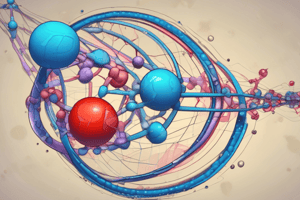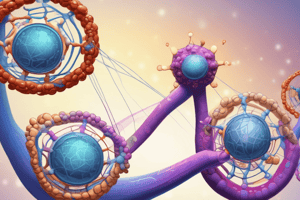Podcast
Questions and Answers
What is the primary function of introns in gene structure?
What is the primary function of introns in gene structure?
- Code for amino acids in proteins
- Non-coding sequences that separate exons (correct)
- Regulate transcription of genes
- Stabilize the mRNA during translation
Which component directly interacts with mRNA during translation to facilitate protein synthesis?
Which component directly interacts with mRNA during translation to facilitate protein synthesis?
- Ribosomal RNA (rRNA)
- DNA polymerase
- tRNA (correct)
- RNA polymerase
What is the role of the Poly A tail attached to the 3' end of mRNA?
What is the role of the Poly A tail attached to the 3' end of mRNA?
- Assist in ribosome binding
- Protect RNA from degradation (correct)
- Promote transcription of RNA
- Facilitate splicing of introns
Which of the following elements is considered a cis-acting element?
Which of the following elements is considered a cis-acting element?
What is the end result of alternative splicing in mRNA processing?
What is the end result of alternative splicing in mRNA processing?
Which technique is utilized for detecting mRNA expression?
Which technique is utilized for detecting mRNA expression?
Which property characterizes transcription factors?
Which property characterizes transcription factors?
What does the promoter region of a gene primarily regulate?
What does the promoter region of a gene primarily regulate?
Which of the following describes the role of ribosomal proteins in translation?
Which of the following describes the role of ribosomal proteins in translation?
What is the main purpose of Reporter gene technology?
What is the main purpose of Reporter gene technology?
Flashcards are hidden until you start studying
Study Notes
Gene Regulation
- Same genetic material gives rise to diverse tissues and cell types.
- Key components include water, ions, organic molecules, nucleic acids, proteins, lipids, and sugars.
Nucleotides Structure
- 2’ Carbon: Ribose (RNA) contains H; 2’ C has hydroxyl (OH) group.
- 1’ Carbon: Contains nitrogenous bases; Purines (Adenine, Guanine) and Pyrimidines (Thymine/Uracil, Cytosine).
- 5’ Carbon: Phosphate (PO4) group is connected here.
- 3’ Carbon: Hydroxyl (OH) group is present, critical for RNA structure and function.
Gene Structure
- Exons: Coding sequences that translate into amino acids (proteins).
- Introns: Non-coding regions that interrupt exons, not translated into protein.
- Promoter: Regulatory sequences that control transcription initiation; consists of core promoter, distal and proximal components, and untranslated regions (UTRs).
Transcription Process
- Gene information is transcribed from DNA to RNA by RNA polymerase.
- Resulting RNA retains both introns and exons initially as pre-messenger RNA.
- RNA Splicing: Introns are removed; exons are joined together, and 5’ cap is added for stability.
- Poly A tail is added to 3’ end before mRNA is exported to cytosol.
- Alternative splicing results in different amino acid sequences and altered reading frames.
Translation Process
- mRNA, produced during transcription, translates into proteins in the cytoplasm.
- mRNA binds to rRNA and ribosomal proteins, forming a ribosomal complex.
- tRNA transports specific amino acids to ribosome, matching mRNA codons.
- Peptide bonds form between amino acids, resulting in protein synthesis.
Transcriptional Gene Regulation
- Regulates the activation or silencing of genes.
- Modifies the rate of mRNA processing, stability, and efficiency of translation into proteins.
Gene Regulatory Elements
- Cis-acting Elements: DNA sequences that recruit trans-acting factors; include promoters, enhancers, and silencers.
- Trans-acting Elements: Nuclear proteins, including transcription factors and cofactors that bind to cis-elements to regulate gene expression.
- Specific transcription factors recognize and bind to consensus sequences to activate or repress target genes.
Protein Expression Detection Methods
- Immunohistochemistry: Antibodies used to visually detect specific proteins within cells, tagged for observation.
- Western Blot: Proteins separated via acrylamide gel electrophoresis, transferred to a membrane, and probed with specific antibodies.
mRNA Expression Detection Methods
- Northern Blot: Probes nucleic acids; similar concept as Western blot, but targets RNA.
- RT-PCR: Reverse transcription of mRNA to cDNA, followed by amplification through PCR.
- In Situ Hybridisation: Utilizes RNA probes to detect specific mRNA, labelled for observation.
- RNA-Sequencing: Advanced sequencing techniques to quantify transcript levels, including mRNA isoforms and non-coding RNAs.
- Microarray: Analyzes expression of multiple genes simultaneously by hybridizing fluorescently tagged mRNA to a chip.
Gene Expression Detection
- Reporter Gene Technology: Modifies a gene’s promoter to include a reporter gene, enabling visualization of gene activity via fluorescence.
Studying That Suits You
Use AI to generate personalized quizzes and flashcards to suit your learning preferences.




